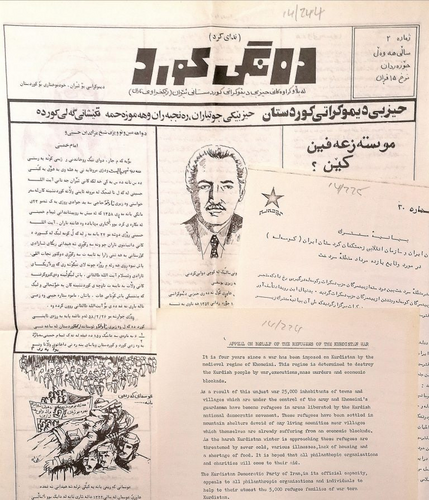Read the first part of this article here
It should be noted that all the newspapers and magazines were published in the Central Kurdish (Sorani) dialect. The future of Kurdish literature was further developed in the light of contacts with Western and Arabic literature. Initially, Kurdish intellectuals and writers translated a large number of scientific, literary, and travelogues from Arabic and English into Kurdish. Articles about Kurds and Kurdistan were published in the writings of English and European tourists and Arabic magazines, they translated them into Kurdish and some researchers spent their time publishing grammar of the Kurdish language, culture, and folklore, and they were very interested in Kurdish history, geography, literature, and poetry. Obviously, listing the names of hundreds of Kurdish writers is beyond the scope of this article.

The photo of the second issue of the newspaper Voice of Kurds
Although it is recalled that the press and publishers prepared literary, historical, poetry, and story articles for their readers until 1958 but consciously discussed the issues of the day and national and nationalist themes were presented only in the form of poems and legends of the past; after August 1958, when the Kurds got freedom of speech, they immediately demanded nationalism. After the July 1959 coup, Kurdish writers celebrated the victory of the Kurdish and Arab Democratic Republics in poetry and writing. The brotherhood of Kurds and Arabs was recognized as the foundation of Iraq and the Education and Scientific Training Unit was established to establish Kurdish schools and universities. A six-member committee was appointed to prepare books on Kurdish history, geography, and literature in Arabic and Kurdish. Then, Kurdish was included in the curriculum of the Iraqi Arabic Department and some of the Kurdish demands were met in the cultural and administrative fields, but in early 1961 the situation changed.

An old photo of the Hiwa newspaper
Kurdish Cultural Movement in the North part of Kurdistan and Turkey
The Kurdish cultural movement in the northern part of Kurdistan and Turkey has been in a sad situation because the unchanged Turkish policy of considering the Kurds as Turks (in Turkey, the Kurds are called mountain Turks) can be seen as one of the consequences of the repression of the Kurds under this cultural poverty. However, due to the ignorance of the Turkish authorities, Kurdish culture did not stop growing and spreading. Kurdish books were sold secretly, and according to the Turkish newspaper Istanbul on November 6, 1960, Kurdish books printed in the Southern part of Kurdistan and Iraq were secretly smuggled into the northern part of Kurdistan and Turkey and sold next to mosques.

An old photo of the Kurdistan flag in a Turkish newspaper in the 1930s
In September 1995, Kurdish representatives, supported by a large number of intellectuals, called on the Turkish government to publish newspapers in Kurdish; however, their request was rejected by the Turkish authorities. A month later, despite the ban, a selection of Kurdish poetry was published in Amed and the publisher was immediately prosecuted. Twelve lawyers volunteered to defend the publisher, and the case ended there. Therefore, we can predict the political issues in the northern part of Kurdistan and Turkey.

A photo of issue 217 of the newspaper Walat
Kurdish Cultural Movement in the East part of Kurdistan and Iran
It must be admitted that the Kurdish cultural and press position in the East part of Kurdistan and Iran has not been very bright because governments have always pursued a policy of equalizing Kurds and Persians. In addition, on April 27, 1959, the Iranian authorities issued a license to publish a literary and information newspaper called Kurdistan in Tehran. As soon as the first issue of the newspaper was published, the newspaper began translating articles from Persian. The Kurdistan newspaper was published in the local dialect of Sna (Sanandaj) and the Persian alphabet. The number of issues of prints was limited and it was not sold in Kurdish cities. There were no Kurdish-language primary and secondary schools in the eastern part of Kurdistan and Iran, except a chair in Kurdish at Tehran University, until the establishment of the Kurdish Language and Literature Department at Kurdistan University in Sna. For this reason, cultural and literary activities were not widespread among the Kurds and only during the Kurdistan Republic in Mahabad in 1946 did cultural and literary activities in the Kurdish language develop significantly. During the eleven months of the Kurdistan Republic, more than 100 issues of the Kurdistan newspaper, a magazine called Kurdistan, a children's magazine called Grugali Mindalan, and another magazine called Halala were published. Kurdish poetry and stories developed and poets such as Hazhar, Hemn, Haqiqi, Khalamin, Sayd Kamil, Atri Glolani, and Hedi and writers such as Abdulrahman Zabihi, and Hassan Qizilji published articles in the newspapers of the Kurdistan Republic. In the field of history, we can mention the book “The History of Kurds and Kurdistan” by Sheikh Mohammed Ayatollah Mardokh Kurdistani.

The photo of the tenth issue of the Kurdistan newspaper – Kurdistan Republic
Sources:
1. Geew Mukriani.Dictionaric arabe_ kurde de 15000 mots.
2. cahier N I.Note sur lalphet Kurdc.
3. le problème kurde - joyce blau.
4. CF.R.P.Thomas Bios. Op cit PP212_213. CF egalemnt C.J.R.A.C.S. 1954.







